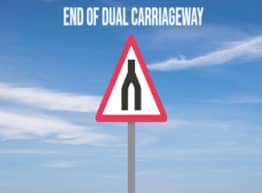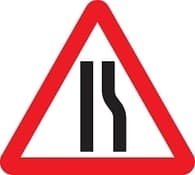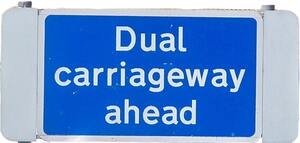End of Dual Carriageway Sign
The end of dual carriageway sign is a warning traffic sign. This communicates to the drivers that the one-way road is ending ahead. Therefore, it is very important for all drivers to know about the end of dual carriageway sign and drive accordingly for safe driving on the road.
End of Dual Carriageway Sign Meaning
The end of dual carriageway sign warns the drivers that the section of one-way traffic is going to end. The end of dual carriageway sign also informs the drivers that they are approaching a single-carriageway road. So, they have to follow the rules and conditions of two-way traffic after leaving the dual carriageway.
More importantly, whenever as a driver you see the end of a dual carriageway sign, then always slow down your speed. Because the legal speed limit on a single-carriageway is different than on a dual-carriageway.
Similarly, driving conditions are also different on both roads. In addition, on a dual carriageway, traffic on both sides is separated by a central reservation. which may not be present on a single-carriageway road.

Therefore, be careful while driving as you see the end of dual carriageway sign. Always slow down and obey traffic laws to avoid any mishap. This question can be on your driving test paper as well. However, in the driving test, you will face this question in such a way as below. Among the given options, you have to tick the right one in your answer.
which sign means the end of the dual carriageway?



Dual Carriageway Sign
A dual carriageway sign indicating dual carriageway ahead is put along the road as you approach a dual carriageway. In many countries, including the United Kingdom, this sign is used to inform drivers that they are approaching a road with two separate carriageways, each having multiple lanes of traffic and typically divided by a central reservation or median.

Dual Carriageway sign usually consists of a blue rectangular background with a white symbol. In order to symbolize a dual carriageway, two parallel, divided highways are frequently shown. The sign might also include text below the symbol to indicate “Dual Carriageway Ahead” or a similar message.
End of Dual Carriageway Sign Speed Limit
There isn’t a specific “end of dual carriageway sign” in the UK that directly indicates a change in speed limit. The speed limits on roads in the UK are typically indicated by round signs with a red circle border and a number in the center, indicating the maximum speed allowed in miles per hour (mph).
Unless otherwise posted, the default speed limit on a dual carriageway is typically 70 mph (miles per hour). The new speed limit, which may be 60 mph, 50 mph, or a different restriction depending on the type of road you’re entering to, will typically be indicated by a road sign as you approach the end of dual carriageway sign.
Dual Carriageway Speed Limit
| Cars, Bikes, and Car-derived vans | 70 mph |
| Speed Limit for Car with a trailer | 60 mph |
| Buses and Coaches up to 12 meters long | 60 mph |
| Goods Vehicles up to 7.5 t | 60 mph |
| Goods Vehicles over 7.5 t in Scotland | 50 mph |
Single Carriageway Speed Limit
| Cars, Bikes, and Car-derived vans | 60 mph |
| Speed Limit for Car with a trailer | 50 mph |
| Buses and Coaches up to 12 meters long | 50 mph |
| Goods Vehicles up to 7.5 t | 50 mph |
| Goods Vehicles over 7.5 t in Scotland | 40 mph |
Always pay attention to traffic signs as you switch from one type of road to another and change your speed appropriately.
A single-carriageway road has this sign


Frequently Asked Questions (FAQs) concerning End of Dual Carriageway Sign
What is the Speed Limit at the End of Dual Carriageway Sign?
There isn’t a specific speed limit associated with the “end of dual carriageway sign” in the UK. The sort of road you’re entering (such as a single carriageway road) and any posted speed limit signs will often decide the speed limit at the end of a dual carriageway.
When you encounter the end of dual carriageway sign, it’s important to watch for any new speed limit signs that might be posted on the road you’re transitioning to. The legal speed limit for a single carriageway road is typically 60 mph, unless otherwise posted, if there are no special speed limit signs.
What is the Speed Limit after the End of Dual Carriageway Sign?
In the UK, road signs are frequently used to indicate the speed restriction following the end of a dual carriageway sign. The default speed limit for a single carriageway road (which is what most highways return to after a dual carriageway finishes) is 60 mph (miles per hour), unless otherwise posted, if there are no particular speed limit signs present.
FIND OUT MORE:-
End of Motorway Sign: What does it mean?
What is the speed limit on a dual-carriageway?
Flagger Ahead Sign, What does it mean?
A no-stopping sign at any location – What does it mean?
Freeway vs Highway – What is the difference?
No parking sign at a certain location – What does it mean?
Do you know the proper way to enter an expressway from the entrance ramp?
A no-standing sign at a certain location – What does it mean?
Expressway vs Highway – What is the difference?

